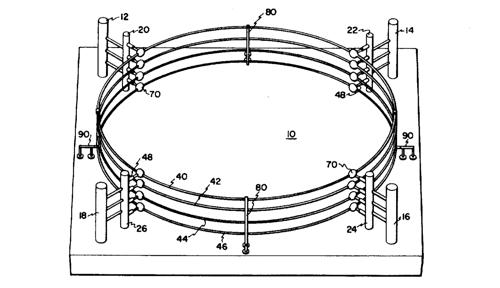Circular Boxing Rings
In 1975, Marvin Jenson received a patent (No. 3,876,197) for a circular boxing ring. As he noted in his patent, a circular ring is safer than a square one due to the lack of corners:
In a newspaper interview, Jenson further explained that the idea for the round boxing ring had occurred to him after watching the 1961 fight between Benny Paret and Emile Griffith, during which Paret got trapped in a corner and took such a beating that he fell into a coma and died.


Jenson was hardly the first person to come up with the idea of a circular boxing ring. The idea has been around for a long time. In fact, way back when fighters used to compete in circles drawn on the ground, which is why boxing rings came to be referred to as 'rings' in the first place, rather than 'squares'.
So how did boxing rings end up being square and continue to be so?
As far as I can tell, it's mostly a matter of convenience. It's easier to string rope in a straight line rather than a circle.

Many times during a boxing contest one of the contestants will be trapped in a corner and is unable to escape the ensuing onslaught of his opponent. This may result not only in a serious physical injury to the trapped fighter, but also detracts from the art and skills of the sport.
In a newspaper interview, Jenson further explained that the idea for the round boxing ring had occurred to him after watching the 1961 fight between Benny Paret and Emile Griffith, during which Paret got trapped in a corner and took such a beating that he fell into a coma and died.

Jenson's patent drawing

Jenson's circular ring in use
Jordan Valley Sentinel - June 10, 1976
Jenson was hardly the first person to come up with the idea of a circular boxing ring. The idea has been around for a long time. In fact, way back when fighters used to compete in circles drawn on the ground, which is why boxing rings came to be referred to as 'rings' in the first place, rather than 'squares'.
So how did boxing rings end up being square and continue to be so?
As far as I can tell, it's mostly a matter of convenience. It's easier to string rope in a straight line rather than a circle.

An earlier attempt at a circular ring
Newsweek - May 8, 1944
Comments
On the one hand, it's not a bad idea.
On the other, it might have its own undesired consequences. For instance, if a boxer is on the ropes now, he can at least try to hide in the corner and block everything. In a round ring, maybe he'll be chased round and round with nowhere to stop.
Worth a try, though.
On the other, it might have its own undesired consequences. For instance, if a boxer is on the ropes now, he can at least try to hide in the corner and block everything. In a round ring, maybe he'll be chased round and round with nowhere to stop.
Worth a try, though.
Posted by Richard Bos on 10/30/22 at 05:06 AM
It appears that the “ropes” on Jensen’s ring are rigid and therefore potentially dangerous to the boxers.
Posted by Brian on 10/30/22 at 11:52 AM
Commenting is not available in this channel entry.

Category: Sports | Martial Arts | Patents